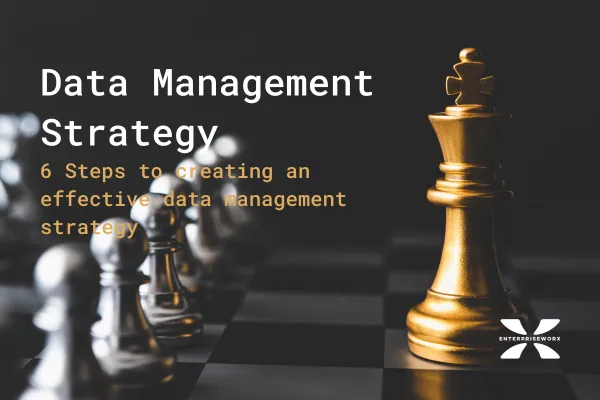ENTERPRISEWORX BLOG

6 Steps to an Effective Data Management Strategy
Data has become the backbone of every organisation. From customer data to financial records, organisations rely heavily on data to make informed decisions, gain insights, and drive business growth.
However, managing this data effectively is daunting, given the vast amounts of data generated daily. This is where a data management strategy comes in.
The absence of a data management strategy can expose an organisation to various risks:
Incompatible, duplicate, or missing data resulting from undocumented or inconsistently documented sources can undermine the accuracy and reliability of the organisation's data.
Siloed projects that use the same data but duplicate efforts and costs associated with that data can lead to inefficient use of resources.
Data activities that do not contribute to overall business objectives can consume time and resources that can be channelled into more productive areas.
These risks emphasise the need for organisations to implement an effective data management strategy to mitigate data-related risks and ensure that the data is accurate, complete, and secure.
What is a Data Management Strategy?
A data management strategy is a comprehensive plan that outlines how an organisation collects, stores, processes, protects, and utilises its data effectively to achieve its business objectives. It involves identifying the data sources, defining data quality standards, establishing data governance policies and procedures, ensuring data security and privacy, and managing the data throughout its lifecycle.
A data management strategy aims to ensure that the organisation's data is accurate, complete, and trustworthy while also ensuring that it is accessible to authorised users and protected from unauthorised access. The strategy also includes processes for integrating data from multiple sources, ensuring data quality, and optimising data usage.
A well-defined data management strategy should address the following components:
Data Governance: Establishing policies, procedures, and standards for data management to ensure data accuracy, consistency, and compliance with regulations.
Data Quality: Implementing processes for identifying and correcting data quality issues, such as cleaning, validation, and standardisation.
Data Security: Ensuring that data is protected from unauthorised access, theft, or loss through encryption, access controls, and other security measures.
Data Privacy: Implementing measures to protect individuals' privacy rights by ensuring that personal data is collected, processed, and used in compliance with applicable privacy regulations.
Data Integration: Integrating data from multiple sources creates a unified view of the data, enabling better decision-making and analysis.
Data Lifecycle Management: Managing the data throughout its lifecycle, from creation to deletion, to ensure it is appropriately stored, archived, and destroyed.

Here are the six essential steps to creating an effective data management strategy:
Step 1: Identify Data Sources
The first step is to identify all the data sources within the organisation. This includes structured and unstructured data sources, such as databases, spreadsheets, files, and social media. By identifying all the data sources, organisations can ensure that they are aware of all the data they are collecting and can manage it effectively.
Step 2: Define Data Quality Standards
Once the data sources are identified, it is crucial to define data quality standards that specify what constitutes accurate, complete, and trustworthy data. This includes identifying data validation rules, cleansing procedures, and standardisation practices. By establishing data quality standards, organisations can ensure their data is accurate and trusted.
Step 3: Establish Data Governance Policies
You should establish data governance policies and procedures to ensure that the organisation's data is managed effectively. This includes defining data ownership, roles, and responsibilities and setting data access controls and retention policies. By establishing data governance policies, organisations can ensure their data is managed effectively and securely.
Step 4: Ensure Data Security
Data security measures must be implemented to protect the organisation's data from unauthorised access, theft, or loss. This includes implementing access controls, data encryption, and data backup and recovery processes. By ensuring data security, organisations can protect their data from threats and ensure it is available when needed.
Step 5: Implement Data Integration
Integrating data from multiple sources can provide a unified view of the data and enable better decision-making. This includes establishing data integration processes and tools, such as ETL (Extract, Transform, Load) processes and data integration platforms. By integrating data from multiple sources, organisations can gain valuable insights and make informed decisions.
Step 6: Manage the Data Lifecycle
Managing the data throughout its lifecycle, from creation to deletion, is critical to ensuring that it is accurate, complete, and secure. This includes establishing data retention and archiving policies and procedures and data destruction practices. Organisations can ensure that their data is properly managed and secured by managing the data lifecycle.
In conclusion, an effective data management strategy is essential to the success of any organisation. By following the six essential steps outlined above, organisations can develop a comprehensive data management strategy that aligns with their business objectives and enables them to make informed decisions based on reliable data. With an effective data management strategy, organisations can harness the power of data to achieve their goals and stay ahead of the competition.
At EnterpriseWorx, we understand the importance of data management and its impact on business success. As data-to-decisions partners, we can guide you on the entire road from data management to business intelligence. Our team of experts can help you assess your current data management and governance practices, identify gaps and areas for improvement, and develop a roadmap for implementing effective solutions.
Contact us today at www.ewx.co.za or email info@ewx.co.za to learn how we can help you improve your data management and governance practices and gain a competitive advantage in your industry.

ABOUT
+27 11 301 0900
South Africa
01 Sturdee Avenue
Rosebank, JHB, 2196
United Kingdom
1 Moorfield Close,
Moorfield Business Park, Leeds, LS 197YA
Copyright 2003-2023 EnterpriseWorx IT (PTY)LTD